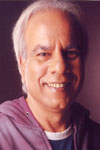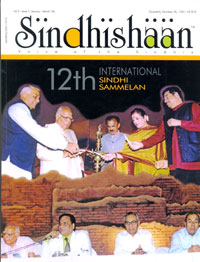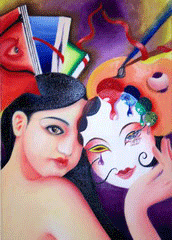PRIDE AND PREJUDICE
by - Arun Babani

One single most important casualty of partition and displacement of the Sindhi community is their self pride. Because of their rootlessness, their language and culture took a back seat, and the net result was the lack of pride felt at being Sindhis.
Actually, as the ‘Outlook’ survey of India about Indian youth proved, most Indians don’t feel proud of being Indian; they know that they are being negatively perceived by their western counterparts. This also explains the exodus that is taking place westwards of all educated Indians. And so if the label Indian doesn’t fit well with the youth, how can the label Sindhi fit well enough to take pride in?
The Sindhi pride or whatever is left of it is largely based on ‘Assanjo Abano Warso’, being propagated by elder Sindhis born in Sindh. The most important ingredient of tradition as a metaphor for pride is it’s so called rich Sindhi culture originating in the Sindhu Valley Civilization on the banks of the river Sindhu. Fossils of Mohen-Jo-Daro are often cited as the inheritance of Sindhis, it being the oldest civilization on earth, thereby the most prestigious, pure and award-worthy. Apart from this ancient treasure the Sindhis have not much to offer themselves and their youth by way of a matter of pride.
Let us now examine what actually are the scientific bases for a pride that a person, community or a nation feels for itself. Pride is a different concept than Ego or Individualistic self. Self pride need not be ‘Ahankaar’or blatant Jingoism. A natural self concept is more like a healthy self acceptance as against bullying others. A self concept based on normal human achievements and shortcomings is more like a sane self acceptance, which would not require a community to greet each other as ‘Jai Sindhi’. Imagine if we had greetings like ‘Jai Bangali’, ‘Jai Gujrati’.It would then become loud speakers vying for power over each other.
The Sindhis lost their self concept and pride after partition and displacement. In Sindh, before partition, there doesn’t appear any trace of inferiority or lack of pride among Sindhis. But subsequently in refugee camps and transit houses where they had to compete with other local communities in India, they heard things like ’Yeh sallaa Sindhi log’, which seems to have caused a break in their psyche , a confusion as to who they actually are.
Today, however, over five decades later, the situation seems to be much better as Sindhis are generally accepted and welcomed in every field. This seems apparent from the fact that over the years local political parties have attacked every kind of community, including south Indians, UPites, Biharis, but never the Sindhi community. Locals do not perceive us as a threat but they see us as assets, where they can work and get jobs with Sindhi firms.
So, today if we have to teach our young Sindhis to feel confident and proud as members of the Sindhi community, we can’t rely on fossils and fingerprints of the past. Neither can we have pompous greetings like ‘Jai Sindhi’. We need to show them something much more to actually belong to the community. What can that be!
Dr. Satish Rohra has been lecturing the Sindhi youth with just such a project. He tells them about Raja Dahir, about Raidiyach, and other heroes from the Sindhi History. What has been their response? “Not much”, he says, “Sindhi youth are very intelligent. They ask questions. They want to know more, they want something solid to feel proud of. Together all of us must think and offer them something real to hang their self respect on.”
In each Bengali house there is a portrait of Rabindranath Tagore. In Parsis there is Tata. Punjabis have a substantial presence in Theatre, Arts and Cinema. What can the Sindhi community showcase as a matter of pride? Atleast today’s headlines about the illegally built Ulhasnagar goes totally against their image. One thing that Sindhis have to really showcase is their contribution in the field of Education, Healthcare and Housing infrastructure. But even these activities are semi-commercial and Mumbai’s Jaslok Hospital caters to the wealthy Arabs who come down to enjoy Mumbai monsoons..
Is money and wealth, our penchants for luxuries and good life our new identity which could attract the youth to the Sindhi way of life? But there is nothing specifically Sindhi about wealth and money. We need symbols, cultural icons to enrich our self concept. Actually, it is in the total absence of roots and culture that certain sections of the Sindhi community started taking pride in their rich life style and flashy ways. When they couldn’t show off their unique self identity, they felt obliged to show off their necklaces and diamonds. The young generation can’t be satisfied even with these ingredients of confidence and pride. They need, as Dr. Rohra put it “something solid to put their feet on.”
Most of the Sindhi consciousness has been erased over the years after partition, just as most of the Indian traditional consciousness is being erased in the wake of globalization and one single world culture. So to think of a unique Sindhi concept and pride seems elusive. In other words, since there is nothing left of that old Mohen Jo Daro Sindhi culture, to perform a typical Sindhi community plastic surgery on the lost pride seems a very shaky project. Besides, that old wound of partition and subsequent dehumanization have healed with time, and a new Sindhi doesn’t hold any memory or scars of that horrible event, rather the new young Sindhi is totally unaware of what his forefathers had to forgo for him to feel a normal and sane human being today. In the absence of any unique and typical Sindhi cultural psyche, there is an automatic absence of any lack or self pity among the young generation of Sindhis. This fact alone makes the problem of pride and confidence redundant and obsolete.
The ‘Jai Sindhi’ was a wounded response to the ‘Tum Sallaa Sindhi’; in today’s changed circumstances both these idioms are out of tune and an insult or a false pride are both based on limitations of ignorance. Sindhis, along with other enlightened communities have crossed such unnecessary barriers of tradition and we no longer need adages to describe or superimpose on our minds.



